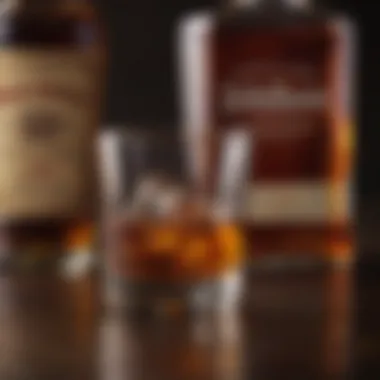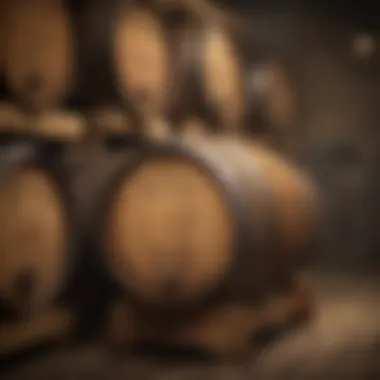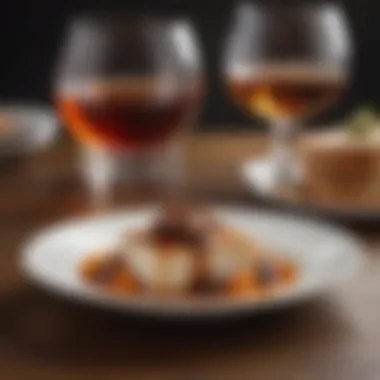Understanding Bourbon: Characteristics and Culture


Intro
Bourbon is more than just a spirit; it is a cultural icon that evokes a sense of history, craftsmanship, and culinary excellence. Rooted in the traditions of American distillation, understanding bourbon is essential for both enthusiasts and casual drinkers alike. This exploration aims to examine the various aspects that contribute to bourbon's identity, including its unique characteristics, production methods, and its esteemed place within gastronomy.
In this article, we will regularly use terms relevant to bourbon, which will help in understanding its complexity. Terms like mash bill, proof, and char levels will be defined and discussed in context to elevate the reader's comprehension of the subject. The aspiration is not only to inform but also to enhance appreciation for this iconic spirit.
"Bourbon is America’s only native spirit, a drink that embodies the spirit of innovation and craftsmanship."
Throughout each section, we will uncover insights on how bourbon is produced, how its distinct flavor profiles are formed, and explore the significant role it plays within contemporary mixology. Additionally, food pairings and tasting notes will be addressed, aiming to provide a comprehensive guide for those wanting to integrate bourbon into their culinary experiences.
As we embark on this detailed understanding of bourbon, we will emphasize the importance of its American roots and cultural significance. By the end of this article, readers will have a well-rounded understanding of bourbon and by extension, a deeper appreciation of its elegance and complexity.
Defining Bourbon
Defining bourbon is crucial to understanding its identity as a distinct American spirit. Bourbon possesses unique characteristics governed by regulations and traditions that shape its production and consumption. This section will clarify what bourbon is, explore its legal definitions, and assess its defining traits. By elucidating these aspects, readers can appreciate why bourbon stands apart in the wider world of spirits.
Legal Definition of Bourbon
Bourbon must meet certain legal criteria to be classified as such. According to the U.S. Congress regulations, bourbon must be made from a grain mixture that contains at least 51% corn. It has to be distilled to no more than 160 proof and entered into the barrel at no more than 125 proof. Moreover, bourbon must be aged in new charred oak barrels, although there is no minimum aging period for whiskey labeled simply as bourbon. To gain the label "straight bourbon," the spirit must be aged for at least two years. This regulatory framework ensures that bourbon retains its unique flavor profile and is recognized globally as an authentic American spirit.
Key Characteristics of Bourbon
Bourbon has several key characteristics that define it. First, the predominant use of corn contributes to its sweetness, which is often enhanced by notes of vanilla and caramel from the charred oak barrels. Moreover, the distillation process determines the smoothness and richness of the spirit. Aging influences the depth of flavors as well; longer aging generally results in more complex taste profiles.
Consumers should also note that the absence of additives in bourbon distinguishes it from other spirits. By law, only water or a distilled spirit can be added, ensuring a pure representation of its ingredients. The unique combination of these traits defines bourbon as a versatile spirit enjoyed neat, on the rocks, or in cocktails.
Difference Between Bourbon and Whiskey
While all bourbons are whiskey, not all whiskeys can be classified as bourbon. Whiskey is a broad category that includes various types such as Scotch, Irish whiskey, and rye, each with different ingredients and production standards. The most significant differences lie in the grain mash used, the aging process, and geographical origin.
For instance, Scotch whisky is primarily made from malted barley, while rye whiskey must contain at least 51% rye grain. Additionally, Scotch is often aged in used barrels, which impacts its flavor profile differently than bourbon's new charred oak aging. Understanding these distinctions enhances appreciation for bourbon and showcases its unique identity within the larger spirits landscape.
"Bourbon is more than a drink; it's a testament to the cultural heritage and craftsmanship of the American spirit."
As we dissect bourbon’s legalities and characteristics, it becomes evident that its definition is layered, filled with historical and cultural nuances. This foundational understanding sets the stage for exploring bourbon's rich history and evolution in subsequent sections.
The Historical Context of Bourbon
Exploring the historical context of bourbon is essential to understand its significance within American culture and identity. The story of bourbon is intertwined with the nation’s history, showcasing elements of innovation, resilience, and regional pride. Bourbon's development reflects agricultural practices and economic changes throughout the years. Furthermore, its rise in popularity offers insights into social behaviors. By examining its origins and the cultural forces shaping it, readers can appreciate the complexities surrounding this iconic spirit.
Origins and Historical Development
Bourbon’s roots trace back to the late 18th century in what is now Kentucky. The first distillers included early settlers who brought their distillation methods from Europe. Corn was plentiful in Kentucky, and it quickly became a primary ingredient in local whiskey production. The legal definition of bourbon later emerged, with specific regulations set to establish quality and authenticity.
The name "bourbon" is often associated with Bourbon County, Kentucky, although the exact origin of the term remains debated. The distilling practices evolved as local farmers sought innovative ways to preserve surplus corn, leading to a unique product characterized by its sweet flavor and distinctive aroma. With time, this spirit became a staple in regional communities, reflecting local traditions and practices.
Bourbon in American Culture
Bourbon holds a special place in American culture. It symbolizes southern hospitality, tradition, and craftsmanship. Over the years, bourbon became more than just a drink; it became a cultural artifact that represents American history and identity. The spirit is deeply embedded in social rituals and gatherings, enhancing the enjoyment of meals and conversations.
Bourbon has influenced many facets of American life, including literature, music, and art. Writers such as F. Scott Fitzgerald and musical artists in the country genre often mention bourbon, highlighting its significance as a cultural touchstone. Events like the Kentucky Derby are also closely linked to bourbon culture, reinforcing its status as a quintessential American spirit.
Influence of Prohibition on Bourbon
Prohibition in the United States had a severe impact on the bourbon industry. Between 1920 and 1933, the manufacture, sale, and transportation of alcoholic beverages were banned. Many distilleries were forced to close or adapt to new circumstances. Some switched to producing non-alcoholic products, while others entered the black market.
However, this period also saw a resurgence of craft distilling after the repeal of Prohibition. As consumers returned to bourbon, distillers were free to innovate and experiment, leading to diverse bourbon styles and flavors. This adaptation ensured bourbon's survival, setting the stage for the craft bourbon boom that dominates today’s market. The lessons learned during this challenging era continue to shape the industry even now.
"Bourbon is not just a drink. It reflects the journey of American culture, resilience, and reinvention."
Understanding the historical context of bourbon enlightens the reader on how this distinctive spirit evolved and adapted through time. By appreciating its origins, cultural significance, and struggles like those during Prohibition, one gains a deeper respect for bourbon and its place in American heritage.
Ingredients of Bourbon


Ingredients play a vital role in the creation of bourbon. They not only determine the flavor profile but also influence the overall quality of the spirit. Understanding these ingredients provides insight into the subtleties of bourbon and enhances the tasting experience.
Primary Ingredients
Bourbon is primarily composed of four essential ingredients: corn, rye, barley, and water. Each element contributes uniquely to the final product.
- Corn: Must contain at least 51% corn in the mash bill, which adds sweetness and body.
- Rye: Often included, rye contributes spice and complexity.
- Barley: Whether malted or not, barley aids in fermentation by supplying enzymes.
- Water: Essential for mashing and diluting spirits before bottling; the mineral content can affect flavor.
Each ingredient interacts with the others during the production process, resulting in a complex interplay of tastes.
Importance of Corn in Bourbon
Corn is not just a mandatory ingredient; it is the backbone of bourbon’s flavor profile. The high sugar content in corn fermentation yields a natural sweetness that distinguishes bourbon from other spirits. The distinctive character of bourbons, especially from regions like Kentucky, stems from the type of corns used, including heirloom varieties that can impart unique flavor notes.
Corn’s role is crucial in defining what bourbon truly is. For that reason, quality corn selection can elevate a standard bourbon into something exceptional.
Role of Yeast and Water
Yeast and water are critical players in bourbon production. Yeast is responsible for fermentation, converting sugars into alcohol and creating aromatic compounds that enhance flavor complexity. Each distillery may use proprietary yeast strains, leading to a signature taste. Furthermore, water quality is significant as it can affect the mashing process and final product. The mineral content, in particular, can contribute to the mouthfeel and overall finish of the bourbon.
In summary, the interplay among corn, rye, barley, yeast, and water creates an intricate balance that characterizes bourbon. The specific choices in ingredients can lead to vastly different tasting experiences, making the understanding of each element crucial for any bourbon enthusiast.
Production Process of Bourbon
The production process of bourbon is pivotal to its distinct character and quality. This process transforms basic ingredients into a spirit that is rich, complex, and deeply intertwined with American culture. Each step, from mashing to aging, contributes significantly to the flavor, aroma, and overall profile of the final product. Understanding these nuances helps food lovers appreciate the craftsmanship involved in bourbon production.
Mashing and Fermentation
Mashing marks the beginning of bourbon production, where grains are combined with water and heated. This process activates enzymes present in the grains, primarily corn, which convert starches into fermentable sugars. The mash typically consists of at least 51% corn, creating a substrate for the fermentation process.
Once the mashing is complete, fermentation begins. Yeast is introduced to the mash, allowing sugars to convert into alcohol and carbon dioxide. This fermentation typically lasts from three to seven days, depending on desired characteristics. During this phase, the flavor profile starts to develop, with fruity and estery notes appearing, which will be further enhanced during aging.
Distillation Techniques
After fermentation, the resulting liquid, known as “wash,” is distilled. Distillation is essential for concentrating the alcohol and refining its flavors. Most bourbons undergo double distillation in pot stills or column stills. In a pot still, the wash is heated, causing alcohol to evaporate and rise through the column.
The vapor is then condensed back into liquid form. The separation of heads, hearts, and tails during this process is crucial. The heads contain undesirable compounds, while the hearts are the desired product, representing the best qualities of bourbon. The tails, too, possess flavors, but are usually discarded or redirected into the next distillation.
Aging in Charred Oak Barrels
Aging is a transformative step in bourbon production. Once distilled, the spirit is placed in new charred oak barrels. The char layer acts like a filter, pulling out harsh compounds and adding flavor.
Aging bourbon allows it to interact with the wood, which imparts various flavors such as vanilla, caramel, and spice. The aging also mellows the alcohol's harshness, resulting in a smoother finish.
Bourbon must be aged for a minimum of two years to qualify as straight bourbon; however, many high-quality varieties are aged much longer. The time spent in barrels can significantly influence the spirit's taste and complexity. Factors such as warehouse location, temperature fluctuations, and climate play a role in how the bourbon matures, making each batch unique.
"Aging bourbon for years in charred oak barrels is both an art and a science, reflecting the mastery of the distiller."
Types of Bourbon
Understanding the types of bourbon is crucial as it highlights the diversity and richness within this iconic spirit. Each type has its own unique characteristics, production methods, and flavor profiles, which can significantly impact the drinking experience. The classifications also reflect the craftsmanship involved in bourbon making. Consumers can explore various options to find their preferred taste, enhancing their appreciation for this storied drink.
Straight Bourbon
Straight bourbon is a category known for its well-defined standards. To be considered straight bourbon, the whiskey must be aged for at least two years in new charred oak barrels. Importantly, it must adhere to the legal stipulations for bourbon production, including a grain mash bill that consists of at least 51% corn. This type is revered for its direct expression of bourbon's essential qualities, including a balance of sweet, spicy, and oaky flavors.
Given its aging requirement, straight bourbon tends to possess a deeper flavor profile that showcases complexity developed over time. The longer it remains in the barrel, the more prominent the caramel and vanilla notes become. Notably, straight bourbon can be either bottled at a minimum of 80 proof or higher, allowing for a robust taste.
Small Batch Bourbon
Small batch bourbon is produced using a limited number of barrels, generally not exceeding 50. This method allows distillers to focus on quality over quantity, often resulting in unique and artisanal expressions. Each batch may reflect slight variations from the last, adding an interesting layer to the tasting experience.
The term 'small batch' is not rigidly defined by law; therefore, distilleries often market it based on their own selecting criterion. This leads to a wide range of flavors and aromas. Small batch bourbons often highlight innovative techniques and experiments in the distilling process which can appeal to enthusiasts looking for something beyond mainstream offerings.
Single Barrel Bourbon


Single barrel bourbon is an exclusive category that truly stands out. As the name suggests, each bottle of single barrel bourbon comes from one individual barrel. This creates a distinct profile for each bottle, revealing the concentration of flavors specific to that single barrel's characteristics like wood, grain, and age.
Single barrel bourbons tend to have more potent flavors because they are not a blend of barrels. Distillers emphasize uniqueness, often showcasing the influence of that specific barrel on the whiskey. Selection may involve tasting each barrel and determining which ones meet the desired flavor profile for bottling.
For bourbon lovers, single barrel offerings present an exciting opportunity to explore flavors that are often limited and hard to find, leading to a highly personalized drinking experience.
"Bourbon is more than just a drink; it’s a tradition and a testament to American craftsmanship."
In sum, knowing the types of bourbon—straight, small batch, and single barrel—enriches the drinking experience and opens doors to various sensory adventures. Categorizing these expressions allows enthusiasts to better navigate the expansive bourbon landscape.
Bourbon and Mixology
Bourbon has carved its niche in the world of mixology, serving both traditional and innovative roles. The diverse flavors of bourbon make it a versatile spirit favored by bartenders and cocktail enthusiasts. Understanding how to incorporate bourbon into cocktails elevates the drinking experience and opens up a wide variety of flavor profiles.
Popular Bourbon Cocktails
Bourbon's rich and smooth characteristics lend themselves to a range of cocktails. Here are some of the most popular ones:
- Old Fashioned: A timeless choice mixing bourbon with sugar, bitters, and an orange slice.
- Mint Julep: A refreshing blend of bourbon, sugar, mint leaves, and crushed ice, traditional at the Kentucky Derby.
- Whiskey Sour: A tart combination of bourbon, lemon juice, and sugar syrup, often garnished with a cherry.
Each of these drinks emphasizes the unique qualities of bourbon, highlighting its ability to balance sweetness with deeper flavors. Bourbon brings warmth and complexity, appealing to a variety of tastes.
Bourbon's Role in Classic Cocktails
In classic cocktails, bourbon stands as a fundamental ingredient alongside other spirits. It represents a mainstay in bars where tradition meets innovation. Classic recipes that include bourbon often explore the brand's heritage, bridging the past with modern consumption.
- Manhattan: This cocktail combines bourbon, sweet vermouth, and a dash of bitters, creating a sophisticated drink.
- Boulevardier: A twist on the Negroni, it substitutes bourbon for gin, offering a richer profile with the same balance of bitterness and sweetness.
These classic cocktails do not just showcase bourbon's distinct taste but also its capacity to adapt while maintaining its integrity.
Innovative Bourbon Mixology Trends
Contemporary mixologists are experimenting with bourbon like never before. They seek fresh ways to integrate unique ingredients and techniques, expanding the horizons of bourbon cocktails. Ideally, this trend emphasizes creativity without losing the essence of bourbon.
- Infusions: Infusing bourbon with spices, fruits, or herbs results in customized flavors that reflect current culinary trends.
- Barrel-Aged Cocktails: Some bars are aging cocktails in barrels to add layers of complexity, echoing the bourbon aging process. This stylistic choice yields a mellowed, integrated drink.
The innovative approach to bourbon mixology pushes boundaries while respecting the foundation laid by classic cocktails.
As bourbon continues to evolve in the mixology scene, it solidifies its position as a beloved spirit. By understanding its applications in cocktails, one can appreciate not only the drink but also the craftsmanship involved in creating unique flavor experiences.
Tasting Bourbon
Tasting bourbon is an essential aspect of fully appreciating this iconic American spirit. Bourbon is not only a drink; it embodies a rich heritage, complex flavors, and an intricate production process. Understanding how to taste bourbon properly allows enthusiasts to discern its unique qualities, evaluate its quality, and deepen their enjoyment of this beverage. Furthermore, connecting with others over tasting sessions can create a sense of community among bourbon lovers.
How to Properly Taste Bourbon
To properly taste bourbon, one must approach it with a mindful attitude. First, it is crucial to select the right glass, typically a Glencairn glass or a whiskey tumbler. These shapes direct aromas toward the nose, enhancing the tasting experience. Here are the steps to follow for a fulfilling experience:
- Observe the Color: Pour a small amount of bourbon and examine its color. A rich amber hue indicates potential aging and flavor complexity.
- Swirl and Sniff: Gently swirl the bourbon in the glass. This action releases aromatic compounds. Bring the glass to your nose and inhale deeply. Take note of the scents. They may range from caramel and vanilla to dried fruit and spice.
- Taste: Take a small sip and let it coat your palate. Pay attention to the initial flavors, the mid-palate, and the finish. Consider the bourbon’s texture—whether it is smooth or has a certain bite.
- Reflect: After swallowing, think about the flavors and sensations experienced. What lingered? Did it bring any new surprises? Reflect on how different bourbons can evoke distinct experiences.
Common Flavor Profiles
Bourbon's flavor profiles are diverse and depend heavily on its ingredients, production methods, and aging process. Here are some common flavor notes one might encounter:
- Sweetness: Often from the corn and caramelization during aging, flavors like vanilla and toffee are common.
- Fruitiness: Notes of cherry, apple, or dried fruits may emerge, especially in well-aged bourbons.
- Spice: Rye content can add spiciness, with hints of black pepper or cinnamon.
- Oak: Aging in charred oak barrels introduces woodsy flavors, adding depth from toasted notes to nuttiness.
- Earthy Undertones: Various bourbons may display earthy qualities, such as leather or tobacco.
Each bourbon can offer a different combination of these profiles, providing an exciting journey for the palate.
Evaluating Quality in Bourbon
When evaluating the quality of bourbon, several aspects come into play:
- Complexity: A high-quality bourbon often has layers of flavor that unfold slowly, allowing for a rich tasting experience.
- Balance: No single flavor should overpower the others. Good bourbons achieve harmony between sweetness, spiciness, and oak.
- Finish: The finish should be pleasant and well-rounded. A long, smooth finish is often a sign of quality.
- Mouthfeel: The texture of the bourbon—whether oily, creamy, or thin—contributes to the overall experience.
- Craftsmanship: Pay attention to the distillation and aging process. Bourbons from reputable producers often showcase refined techniques leading to superior quality.


Food Pairings with Bourbon
Pairing food with bourbon can greatly enhance the dining experience. Knowing what dish complements bourbon can elevate both the meal and the drink. Bourbon is a complex spirit with sweet, spicy, and smokey notes. This interplay of flavors creates opportunities for remarkable pairings.
Factors like the bourbon's flavor profile, its alcohol content, and the dish’s ingredients play a significant role in these pairings. The right combination can amplify both the bourbon and the food, leading to a satisfying flavor journey. Understanding this enhances appreciation for both the spirit and culinary creations.
Savory Dishes That Complement Bourbon
Several savory dishes align well with bourbon’s unique characteristics. The sweetness found in many bourbons pairs beautifully with saltiness and smokiness of certain foods.
- Grilled meats: The char from grilled steaks or ribs works well with bourbon. A bourbon like Woodford Reserve enhances the savoriness of the meat.
- BBQ: The sweet and spicy flavors of barbecue, particularly those with a ketchup or molasses base, complement the bourbon's inherent sweetness. Brands like Maker's Mark stand up well to the sauce’s richness.
- Cheese platters: Aged cheeses, such as Gouda or cheddar, bring forth a delightful contrast with the bourbon. The creaminess of cheese balances the alcohol's heat.
- Spicy dishes: Bourbon can also pair harmoniously with spicy cuisines, such as Cajun or Mexican food. The hint of sweetness can temper the heat while enhancing the dish’s complexity.
Desserts to Enhance Bourbon Experiences
Desserts can also wonderfully accentuate the drinking occasion with bourbon. The key is to understand how sweetness interacts with bourbon.
- Chocolate desserts: Rich chocolate cake or brownies greatly pair with bourbon. The depth of flavors creates a luxurious experience. Brands such as Buffalo Trace have notes that echo the richness of chocolate.
- Pecan pie: This classic Southern dessert brings out nutty flavors in bourbon. The caramelized sugar contrasts beautifully with the spirit’s flavors.
- Vanilla ice cream: A scoop of vanilla ice cream drizzled with bourbon creates a delectable combination. The cold contrasts against the warmth of bourbon, crafting a delightful sensation in your mouth.
- Fruit tarts: Desserts featuring apples or berries can harmonize with bourbon’s woodsy notes. The fruity acidity cuts through the sweetness of bourbon, providing a refreshing finish.
Bourbon’s versatility in pairing with both savory and sweet dishes uncovers new dimensions of flavor. Experimenting with different combinations can lead to delightful discoveries in taste.
Cultural Significance and Legacy
The cultural significance and legacy of bourbon extend far beyond its production and consumption. Bourbon is not only a drink; it symbolizes a deep-rooted tradition in American history. This section examines how bourbon transcends its status as a mere beverage and becomes an essential part of American identity, contributing to economic, social, and cultural dimensions.
Bourbon as an American Icon
Bourbon is often regarded as a quintessential American spirit, with its origins traced back to the 18th century. The drink has grown in popularity, becoming not only an integral aspect of American culture but also a source of pride. Its designation as the only native American distilled spirit highlights its uniqueness. This distinction fuels its image as an icon of American craftsmanship. The production processes involved reflect a commitment to quality and tradition, appealing to both connoisseurs and casual drinkers alike.
Historically, bourbon has played a crucial role in regional identity, especially in Kentucky, where production is concentrated. The state hosts various distilleries, creating jobs and boosting local economies. The bonds formed among distillers over generations add to bourbon’s rich heritage.
The Bourbon Trail and Tourism
The Bourbon Trail has become a significant tourist attraction in Kentucky, drawing visitors from all over the world. This established trail consists of numerous distilleries, providing guided tours that showcase the bourbon-making process. The experience allows tourists to appreciate not just the product but also the craftsmanship involved.
The economic benefits of the Bourbon Trail cannot be overstated. Visitors contribute to local establishments, including restaurants and hotels, thereby enriching the community. Additionally, the trail fosters an appreciation for heritage and tradition, encouraging interactions between producers and consumers. People often share stories, blending personal experiences with the liquor's rich history, creating a unique connection to the American South.
Bourbon Festivals and Community Events
Bourbon festivals and community events further enhance the cultural fabric surrounding this drink. These gatherings provide an opportunity for enthusiasts to celebrate and experience bourbon in diverse ways. Events like the Kentucky Bourbon Festival draw crowds from diverse backgrounds, showcasing local distilleries, food pairings, and live music.
Such festivals also cultivate a sense of community. They offer a platform for discussions about bourbon's impact on lifestyles and traditions, often featuring educational seminars and tastings. Attendees gain deeper insights into the craftsmanship, while local cuisine often highlights pairings that complement bourbon. These interactions not only educate but also strengthen the bonds within communities, solidifying bourbon's legacy as a vital element of American culture.
Bourbon is not just a drink; it's a narrative woven into the very fabric of American identity, bridging generations and communities.
Contemporary Bourbon Trends
The bourbon industry is experiencing a dynamic transformation as consumer preferences evolve. Understanding contemporary bourbon trends is vital for appreciating how this classic spirit continues to adapt and grow. Recent patterns reflect not only a shift in production methods but also in consumer engagement with bourbon.
Craft Bourbon Movement
The craft bourbon movement has gained significant traction in recent years. Smaller distilleries emphasize quality and traditional methods over mass production. This shift fosters innovation. Consumers often seek unique flavors and experiences. For instance, a growing number of craft distillers experiment with local grains or distinct aging processes. These choices create a varied landscape of flavors.
In addition, many craft distilleries are open to visits and tours. They offer tastings and educational events. This draws in enthusiastic consumers who want to learn more about the bourbon-making process. Craft bourbon invites customers to consider the story behind each bottle. Every batch reflects the craft distiller’s passion.
Craft distilleries are creating potent connections with bourbon lovers, underscoring the importance of provenance and individuality in each spirit.
Sustainable Practices in Bourbon Production
Sustainability initiatives are becoming increasingly important in bourbon production. Many distilleries address environmental concerns through various means. These efforts are not merely about marketing but show a commitment to responsible practices.
Some key sustainable practices include:
- Utilizing renewable energy sources, such as solar or wind power, for distillation.
- Implementing water conservation techniques during production and bottling.
- Sourcing grains from local farms to reduce transportation emissions.
These practices not only benefit the environment but also attract environmentally conscious consumers. The modern bourbon drinker often favors brands that reflect their values. Distilleries that prioritize sustainability may build a loyal customer base.
Innovations in Bourbon Flavoring
Innovation is a driving force in the bourbon industry. Distillers are experimenting with flavoring techniques previously not common in traditional bourbon production. One popular trend is the use of secondary cask finishes.
For example, some producers are aging bourbon in barrels that previously held sherry, rum, or wine. These secondary casks impart complex flavors often not found in standard bourbon. Likewise, other ingredients, such as spices and fruits, are also being used to enhance profiles. These innovative approaches satisfy consumers looking for diverse tasting experiences.















